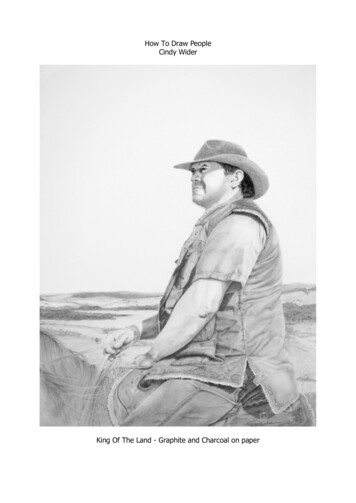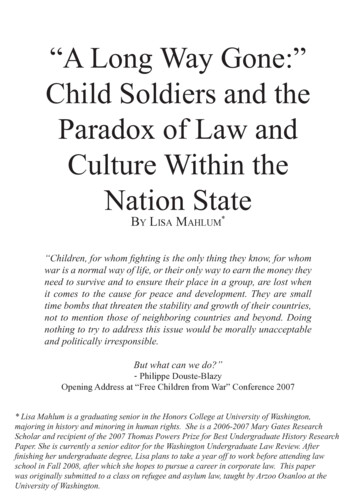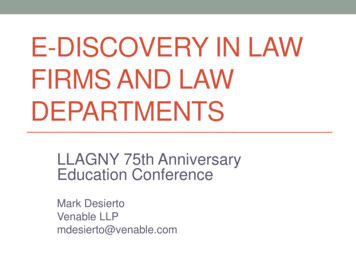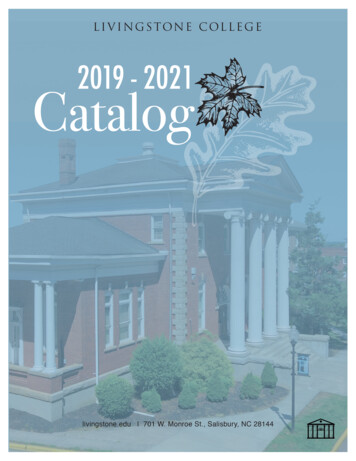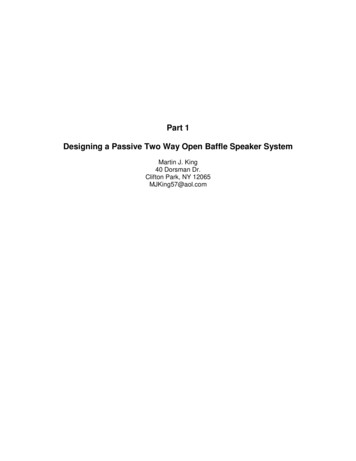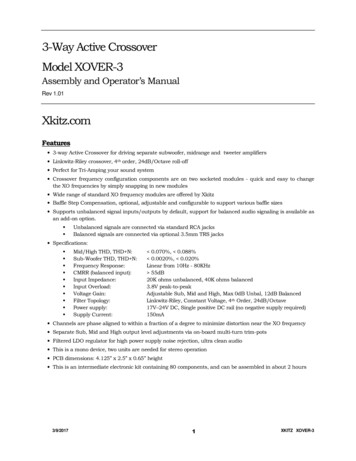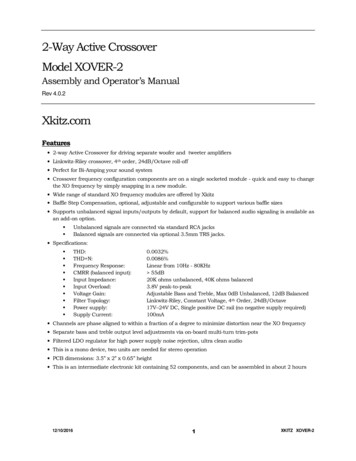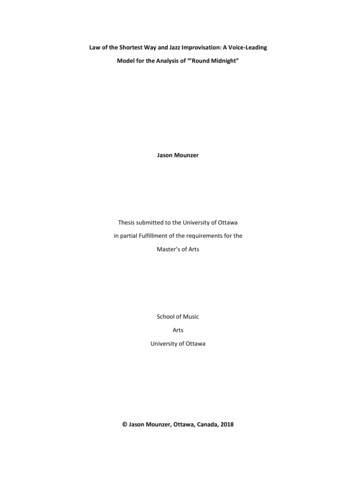
Transcription
Law of the Shortest Way and Jazz Improvisation: A Voice-LeadingModel for the Analysis of “’Round Midnight”Jason MounzerThesis submitted to the University of Ottawain partial Fulfillment of the requirements for theMaster’s of ArtsSchool of MusicArtsUniversity of Ottawa Jason Mounzer, Ottawa, Canada, 2018
iiTable of ContentsList of Illustrations . .ivAbstract . . viGlossary . .viiChapter 1: Introduction . .1Chapter 2: Theoretical Framework . . 10Chapter 3: Methodology . .31Chapter 4: Analysis of Thelonious Monk’s “’Round Midnight” Solo from Monk Alone: The CompleteColumbia Solo Studio Recordings: 1962-1968.Columbia/Legacy. . .44Chapter 5: Analysis of Gerry Mulligan’s “’Round Midnight” Solo from Mulligan Meets Monk:Riverside Records. .1957 . . .55Chapter 6: Analysis of Montgomery’s Solo on “’Round Midnight” From “Wes Montgomery: Live inBelgium 1965” .62Chapter 7: Conclusions. . . 68Bibliography . . . .73
iiiAppendicesLead Sheet . .1Top Lines . . .2Top Line Matrix . . .14Thelonious Monk Solo . 18Thelonious Monk Particles . . .23Gerry Mulligan Solo . .33Gerry Mulligan Particles . .37Wes Montgomery Solo . . .43Wes Montgomery Particles . .51
ivList of IllustrationsFigure 1.1 – Example of a Lead SheetFigure 2.1: Example of Freddie Greene Voice LeadingFigure 2.2: Child’s Figure 5Figure 2.3(a)Figure 2.3 (b)Figure 2.3(c)Figure 3.1 – Demonstration of Top Line, mm 1-4, ‘Round MidnightFigure 3.2 – Demonstration of Top Line MatrixFigure 3.3 – Stage 1Figure 3.4 – Stage 2Figure 3.5 – Particles as notation with Top Line(s) noted aboveFigure 3.6 – Table of Particles as Top Line(s) onlyFigure 4.1: Particle 1 – Thelonious MonkFigure 4.2: Particle 2 – Thelonious MonkFigure 4.3: Particle 5 – Thelonious Monk
vFigure 5.1: Particle 1 – MulliganFigure 5.2: Particle 2 - MulliganFigure 5.3: Particle 3 - MulliganFigure 6.1: Particle 1 – MontgomeryFigure 6.2: Particle 2 - Montgomery
viAbstractThis thesis presents a method of analyzing jazz improvisation and jazz style by using a voiceleading model called “Top Lines.” It compares three separate performances of Thelonious Monk’s“’Round Midnight” by Monk, Gerry Mulligan, and Wes Montgomery. The term Top Lines refers to avoice-leading procedure created by moving as little as possible between chords tones (roots, thirds,fifths, sevenths, and upper functions) of a chordal progression. Top Lines are potential voice-leadinglines in the uppermost register and follow the “Law of the Shortest Way.” The thesis defines TopLines, shows how they interconnect, and ultimately how the improvisor navigates through andmanipulates them. Jazz harmony and improvisation have been explored by scholars such as MarkLevine (1989, 1995), Steve Larson (2005), Henry Martin (1988, 1996), and Steven Strunk (1996).Although many scholars deal with coherence and structure in the improvisation, their discussionsfocus on voice leading coherence and structure in improvisations, where this thesis differs is itprovides a voice-leading model on a small scale within the improvisation itself. The model presentedin this thesis raises the notion of describing jazz improvisation not simply as a motion from onechord tone to another, but instead as motion between voice leading Top Lines. These motionsbetween Top Lines create coherence and motives—called “Particles”— in one’s improvisation.Particles ultimately demonstrate stylistic features in one’s improvisation, motivic connections, andcoherence. The thesis concludes by describing how the Top Line model can be applied to jazzperformance and jazz pedagogy. The thesis will be of interest to scholars of jazz theory, musicology,pedagogy, and jazz performance.
viiGlossaryBridgeThe contrasting section of the form, typically in a ternary form. A standard form for a 32-measurejazz standard would be AABA, with “B” representing the bridge.ChangesThe chord progression of a jazz composition. Jazz musicians improvise solos from the chord tones ofthe chord progression, and from added tones not necessarily indicated in the changes, such aspassing tones or “upper-function” chord tones such as chordal ninths, elevenths, and thirteenths.ChorusA complete iteration of the entire chord changes. Improvisors will often take several “choruses” intheir improvisation, meaning they will solo over the entire form a number of times.Guide TonesThe notes that comprise the voice leading in the chord, typically referring to the third and seventh.HeadThe main melody of the jazz standard.Law of the Shortest WayA term used notably by Arnold Schoenberg to describe the voice-leading practice where each voicemoves as little as possible from one chord to another in a chordal progression. The Law of theShortest Way can be compared in certain respects to the modern theoretical notion of “parsimony.”Lead SheetA way in which the core elements of a standard are notated. Lead sheets usually comprise of amelody and chord changes, thus leaving much room for the performer’s interpretation.ParticlesA motive created by moving from one Top Line to another. Particles are represented through theTop Line Matrix. By means of Particles, the Top Line Matrix can be manipulated and adapted within aspecific section of the tune.StandardA musical work that is commonly played by jazz musicians, thus being associated with the commonor “standard” repertoire of that genre. “’Round Midnight” is a famous jazz standard.Top LineA potential voice-leading model created using the “Law of the Shortest Way” as a means ofnavigating through the changes of the musical work. A Top Line is created by joining tonesof successive chords where these are related by the Law of the Shortest Way. That is to say, a TopLine might be created out of a tone held in common between two successive chords, or where two
viiisuccessive chord tones are a scale step distant from each other. Top Lines can be compared to thevoice parts of a Bach chorale (soprano, alto, tenor, and bass parts).Top Line MatrixA term to describe the interconnection and coherence of all Top Lines and how they relate to eachother, as well as to explain how performers navigate between any given Top Line and to describemotivic Particles
1Chapter 1 - IntroductionThis thesis analyzes three performances of “’Round Midnight” through a proposed “TopLine” model. By analyzing three separate performances—one by Thelonious Monk, one byGerry mulligan, and the last by Wes Montgomery— this thesis provides an analysis thatdemonstrates consistency in one’s improvisation which can ultimately be used to identifystylistic features of each artist. 1 This can help better understand a musician’s approach to playingover a given set of chord changes as well as provide a foundation for those who wish to delveinto improvisation but do not know where to start. However, before all that, at the core of thisthesis is a method of analyzing consistency in one’s improvisation.There have been several jazz theory treatises which discuss the concepts ofimprovisation, the basics of jazz theory, or practical treatises on how to play jazz. Althoughseveral treatises discuss jazz performance and improvisation, few address voice leading in jazzbeyond the guide tone progression of the ii-V-I. Voice leading and connecting adjacent chordsvia guide tone lines are concepts introduced to jazz improvisors early in their pedagogicaljourney. However, a divide exists in both literature and theoretical frameworks of beingperformance-based pedagogy or academic analysis. Furthermore, few theoretical frameworksoffer application for both analysis and performance.1By improvisation, I mean tonal improvisation over a set of chord changes and should not be confused with freeimprovisation.
2Essentially, this thesis explores the idea of describing jazz improvisation not as a motionfrom one chord tone to another, but instead as a motion from one “Top Line” to another. 2 Thisdemonstrates that voice leading can take place between lines implicit within a chord instead ofonly between changing chords. This will be useful to both performing jazz musicians and thosewho wish to explore a different method of jazz analysis. Voice leading, as it is used here, refersto how the improvisor connects chords and navigates between chord tones to create a smoothtransition between chords, but also the lines the improvisor creates within a stagnant chord.Thus, voice leading does not necessitate a change in harmony, only a change in melody or “TopLine.”Work on this thesis began with Professor Dineen in June 2016. In trying to formulate atheoretical framework, Professor Dineen drew upon 2 aspects of his own work. The first ofwhich is the idea of contrapuntal combination, which presents a tabular representation of theactual and possible combinations of the subject and countersubjects in a contrapuntal work suchas a Bach fugue. This directly led to the Top Line Matrix representation, which combines thevarious lines suggested by a chordal progression, creating a multi-layered table. The secondaspect of Professor Dineen’s research that lead to the theoretical framework for this thesis stemsfrom his work on Schoenberg’s Theory of Harmony. Therein, he concentrated on the “Law of theShortest Way,” which Schoenberg follows (albeit often inconsistently) in his theory treatise andelsewhere. This, then, gave me two foundations for my thesis work: the tabular representation ofvoice leading, and the Law of the Shortest Way as a voice leading constraint.2A full definition of “Top Line” is presented in Chapter 2: Theoretical Framework.
3To this foundation, I added several new approaches. I interpreted the chord changes of ajazz standard as a set of lines—the Top Line Matrix—where each line followed the Law of theShortest Way as closely as possible (with certain exceptions). I conceived of an actual jazz sololine as a pattern of shifts between lines of abstract lines of the Matrix, and I derived a means ofdescribing these shifts by using integers, written above the solo, which correspond to theindividual lines of the Matrix. Patterns of shifts occurred and reoccurred at particular moments inthe jazz standard, from improvised chorus to chorus. I proposed the concept of a “Particle” todescribe these recurring patterns. I then applied the theoretical framework to solos by TheloniousMonk, Gerry Mulligan, and Wes Montgomery.“’Round Midnight” is a composition by Thelonious Monk that has entered the jazz canonthrough its performance by many artists. The chromatic ii-V’s make the changes to this standardinteresting for jazz musicians to explore. “’Round Midnight” first appeared on Monk’s 1947album, Genius of Modern Music: Volume 1. Since its release, numerous jazz musicians havetaken creative liberties with both the harmony and melody. Notably Cootie Williams and DizzyGillespie have made significant embellishments in their renditions. Bernie Hanighen added lyricsto the melody.3After its escalade in popularity among the jazz community, “’Round Midnight”became the title and signature track of a 1986 film starring iconic jazz saxophonist DexterGordon. (Dempsey 1987)3Williams and Hanighen’s additions were so monumental that they have since been given partial credits on thecomposition.
4All of these renditions and inclusions of “’Round Midnight” are only a glimpse of thebody of works that include “’Round Midnight” and it has since been gifted the title of the mostrecorded jazz standard that was composed by a jazz musician.4“’Round Midnight” follows a 32-measure AABA form. This means that there is anopening eight-measure phrase that ends with a half cadence which is then repeated but adjustedto conclude with a perfect authentic cadence. (This comprises the “AA” sections of the form.)This is then followed by a contrasting eight-measure section— the B section— which presents avariant chord progression and melody before returning to the A section phrase concluding with aperfect authentic cadence. The phrase structure is further divided into 2-measure sub-phraseswhich all follow a similar contour of an arpeggiated accent followed by a slight descend toresolve the unsettled arpeggio.It was with these things in mind that this particular jazz standard was chosen for thisthesis. Beyond that, however, the specific recordings were chosen for a multitude of reasons.Firstly, they were selected due to accessibility. Transcriptions of these recordings were easilyfound and thus were the first to be analyzed through the Top Line model. Secondly, these artistswere chosen to demonstrate the stylistic differences of each instrument, as well as the individualimproviser. Thus, they were chosen because each recording featured an artist using a differentinstrument to improvise. This became apparent as each piece was analyzed through the variousstages involved with the Top Line mode
1 By improvisation, I mean tonal improvisation over a set of chord changes and should not be confused with free improvisation. 2 Essentially, this thesis explores the idea of describing jazz improvisation not as a motion from one chord tone to another, but instead as a motion from one “Top Line” to another.2 This demonstrates that voice leading can take place between lines implicit within .

